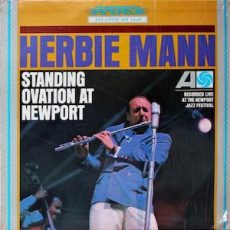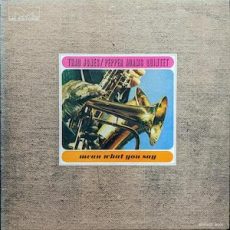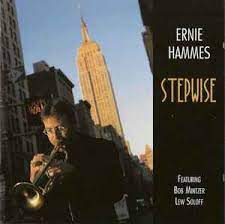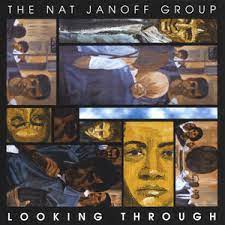
Requisites
Standing Ovation at Newport ~ Herbie Mann | By Eddie Carter
After an exceptionally long week, I was ready to unwind and relax for the evening. So, I began listening to one of Herbie Mann‘s best live performances from the sixties, Standing Ovation at Newport (Atlantic 1445/SD 1445). Three tracks were recorded at the 1965 Newport Jazz Festival, while the fourth is from an earlier date at the Village Gate. The musicians joining the flutist on stage are John Hitchcock and Mark Weinstein on trombone, Dave Pike on vibraphone, Chick Corea on piano, Earl May (tracks: A1, A2, B1), and Ben Tucker (B2) on bass, Bruno Carr on drums, and Carlos “Patato” Valdes on congas. My copy is the 1971 US Stereo reissue.
The set opens with Patato, Dave Pike’s tribute to Carlos Valdes. The rhythm section sets the mood for the ensemble’s festive theme with a lively introduction. Herbie launches the opener energetically; Dave works wonders in the following solo. Carlos answers them with authority next. John and Mike bring the heat in the finale before the octet’s big finish. Stolen Moments by Oliver Nelson begins with the ensemble’s collective introduction, leading to Herbie’s carefree melody. Chick takes charge with a breezy opening statement; next, Herbie goes to work in an enjoyable performance. Dave tickles your ears in the closing chorus before the climax.
Herbie Mann’s Mushi Mushi starts Side Two with a perfect beat for a neighborhood block party. The title’s definition in Japanese means humid and begins with the ensemble’s joyously happy theme. Herbie’s opening solo will put everyone in a festive mood, but the song’s highlight comes with John and Mark’s sensational exchange ahead of the group’s upbeat finale. Herbie introduces the group’s finale, Comin’ Home Baby, by Ben Tucker and Bob Dorough. Ben takes over on bass, with Herbie and Dave as the featured soloists. Both musicians give electrifying performances that bring the crowd to their feet until the song’s upbeat conclusion calls for a well-deserved encore with player introductions.
Buddy Graham and Frank Laico were the recording engineers at The Newport Jazz Festival. Joe Atkinson, Tom Dowd, and Phil Lehle were behind the dials at The Village Gate. The album has a solid soundstage that reflects the enthusiastic energy of both audiences. It’s also a good pressing for a seventies reissue and quiet until the set begins. If you’re in the mood for an outstanding live album with lively performances and tight musicianship, I invite you to check out Standing Ovation at Newport by Herbie Mann on your next record-shopping trip. It’s a wonderful document of two great shows with Herbie at his best that sparkles from start to finish and is a high point in his list of albums!
~ Comin’ Home Baby, Stolen Moments – Source: Wikipedia.org © 2023 by Edward Thomas Carter
More Posts: choice,classic,collectible,collector,flute,history,instrumental,jazz,music

Requisites
Mean What You Say ~ Thad Jones-Pepper Adams Quintet | By Eddie Carter
This morning’s album offered for your consideration brings together two of my favorite musicians, Thad Jones and Pepper Adams, for their only quintet release. Mean What You Say (Milestone MSP-9001) is their only collaborative effort and was recorded around the same time as The Thad Jones-Mel Lewis Orchestra album. Both titles hit the stores in 1966. Thad is heard exclusively on flugelhorn, and Pepper is on baritone sax. The supporting cast is a first-class rhythm section: Duke Pearson on piano, Ron Carter on bass, and Mel Lewis on drums. The program consists of six originals and two popular songs. My copy is the original US Stereo pressing.
Side One opens with the title tune, Mean What You Say, the first of four originals by Thad Jones and one of his prettiest tunes from Presenting Thad Jones-Mel Lewis & The Jazz Orchestra. The quintet opens with a wonderful melody. Duke has the first solo and states his case comfortably. Mel makes a brief comment before Thad’s relaxing statement. Pepper provides the song’s happy ending in the closer ahead of the reprise and the ending. H and T Blues begins with the ensemble’s smooth theme. Pepper takes the lead on the opening solo and cooks, then Thad thrives on the following reading. Duke swings with a smooth tone next, and Ron has a brief word before the closing chorus.
The group takes a spirited turn on Wives and Lovers by Burt Bacharach and Hal David with a lively melody. Thad launches the first reading slowly, then picks up speed to a brisk conclusion. Pepper answers him passionately, and Duke serves up a sparkling statement preceding the closing chorus and quick stop. Bossa Nova Ova is a festive tune with an infectious melody that’s sure to have your toes tapping along to the beat. Pepper is up first; his bubbling enthusiasm lets us know we’re in for a treat. Thad takes a gorgeous solo next; then Duke provides a perfect ending in a well-constructed performance into the song’s reprise and climax.
Side Two gets underway with No Refill. It’s a pretty song that flows like a summer breeze, beginning with the quintet’s theme. Ron starts with a beautiful first reading, and then Thad follows with a leisurely statement. Pepper shines brightly like the sun next, and Duke gives an interpretation as sweet as honey ahead of the theme’s reprise. Little Waltz by Ron Carter is a haunting ballad that opens with the front line’s melancholy melody. Pepper opens with a deeply moving interpretation, followed by Thad’s wonderfully warm statement. Duke is equally polite and respectful next, then Ron walks in last with a lovely finale before the theme’s restatement and tender ending.
Up next is Duke Pearson’s Chant, the pianist first performed on Donald Byrd’s A New Perspective. The ensemble starts slowly for their melody, but the pace picks up for the hearty opening statement by Pepper. Thad comes in next and delivers the second solo efficiently, then Duke delivers the knockout with a splendid performance, leading to the reprise and close. Yes Sir, That’s My Baby by Walter Donaldson and Gus Kahn is an old song from the twenties that the quintet has fun with in the opening and closing choruses with a ragtime feel. In between are three great solos by Thad, Pepper, and Duke, who are all having a blast playing.
Orrin Keepnews produced Mean What You Say, and Elvin Campbell was the recording engineer. The sound quality is exceptional, with a stunning soundstage that transports listeners to the studio as the quintet works. It’s a pity that this group didn’t get to record again because it’s a terrific studio session worthy of adorning a spot in any jazz library. Thad and Mel would assemble The Jazz Orchestra and Pepper Adams would become a significant member of the band’s early Solid State albums. Duke Pearson was a wonderful bandleader and composer who made his home on Blue Note, and Ron Carter was a member of the Miles Davis Quintet before branching out on his own in the seventies.
If you’re in the mood for an excellent Hard-Bop album and are a fan of either musician, I invite you to consider Mean What You Say by The Thad Jones-Pepper Adams Quintet for a spot in your library. It’s an absolute gem in their discography and a terrific release I’m sure you’ll enjoy!
~ A New Perspective (Blue Note BLP 4124/BST 84124), Presenting Thad Jones-Mel Lewis and The Jazz Orchestra (Solid State SS 18003) – Source: Discogs.com ~ Wives and Lovers, Yes Sir, That’s My Baby – Source: Wikipedia.org © 2023 by Edward Thomas Carter
More Posts: choice,classic,collectible,collector,flugelhorn,history,instrumental,jazz,music,saxophone

Daily Dose Of Jazz…
Ernie Hammes was born on August 18, 1968 in Esch-sur-Alzette, Luxembourg and studied at the Conservatories of Esch-sur-Alzette and Metz, France. He would later study at the Manhattan School of Music and the Berklee College of Music in Boston, Massachusetts.
Since 1997, Hammes has performed in New York City, traveled widely to jazz venues and festivals across Europe and North America. The Duke Ellington Orchestra has flourished for over forty-eight years since the death of the Duke, himself. As of 2013, Hammes is the only European known to have been a member of the Duke Ellington Orchestra from any era.
In his native Luxembourg, Ernie is the founder, director and lead trumpet in the Luxembourg Jazz Orchestra and since 1987 he has been a member of the Musique Militaire Grand-Ducale (the Luxembourg Army Band) where he is lead trumpet and, since 1994, leader of the big band.
Trumpeter Ernie Hammes continues to perform, compose and lead orchestras.
More Posts: bandleader,history,instrumental,jazz,music,trumpet

Daily Dose Of Jazz…
Nat Janoff was born on July 13, 1970 in New Jersey and began his musical education on the piano before switching to bass. After hearing Eddie Van Halen he settled on the guitar. Growing up in the 80’s his musical interests were all things rock and metal and soon earned a reputation for being one of the best shred guitarist in the area. However, seeking a platform to improvise longer than a standard rock riff led him to jazz and hearing the Mahavishnu Orchestra’s Birds of Fire for the first time.
He pursued jazz earning his Bachelor of Music degree in Jazz Performance from William Paterson University in 1996 and set to work forging his own musical path.
Recording his debut album, Looking Through, he enlisted the talents of electric bassist, Matthew Garrison and drummer Gene Lake, that showcased him as a player and a composer. Two more albums as a leader followed, a live acoustic date and a studio session, then contributing to the ESC tribute album Mahavishnu Redefined II.
In addition to playing with his own groups, Janoff has performed with Joe, David “Pic” Conley, Norman Simmons and drummer Victor Jones’ group Culturversy, Debelah Morgan, and Roland Clark.
Guitarist, composer and educator Nat Janoff teaches guitar privately, has been a guest instructor at the annual William Paterson University summer jazz camp, and continues to perform and record.
More Posts: bandleader,composer,educator,guitar,history,instrumental,jazz,music

Daily Dose Of Jazz…
Luciano Troja was born in Messina, Italy on July 6, 1963. Self-taught from the age of 6, he studied for several years with the pianist-composer Salvatore Bonafede. In New York City, for a brief and intensive time, he studied with Richie Beirach. He attended several jazz courses and clinics such as Siena Jazz, Berklee Clinics in Umbria, Aebersold School in London, and piano courses with Shirley Scott, James Williams and Franco D’Andrea.
Luciano has performed at festivals and jazz clubs in Europe and the United States. He is the pianist of the Mahanada Quartet, an original combination of free improvisation and written music. He released three CDs with Mahanada that garnered extremely good reviews and recognitions. He released two CDs in duo with the guitarist Giancarlo Mazzù, Seven Tales About Standards and Seven Tales About Standards Vol. 2, both considered as a creative and original approach to the standards.
He along with Salvatore Bonafede of Double Piano Orchestra have recorded Double Rainbow and My Funny Valentine (Wide Sound, 2008).
He has been named Talent of the Year, Pianist of the Year, Group of the Year and CD of the Year in Top Jazz Poll of Musica Jazz magazine. He has since released At Home With Zindars a piano solo project. Pianist Luciano Troja continues to perform and record.
More Posts: bandleader,history,instrumental,jazz,music,piano




